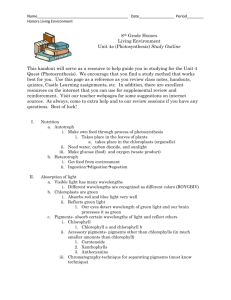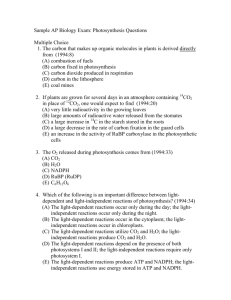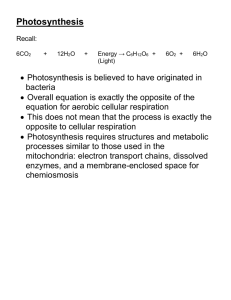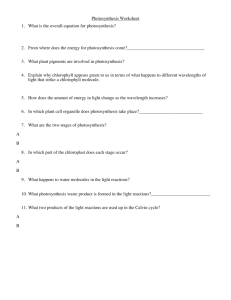AP Biology Photosynthesis Test: Chapter 9 Review
advertisement
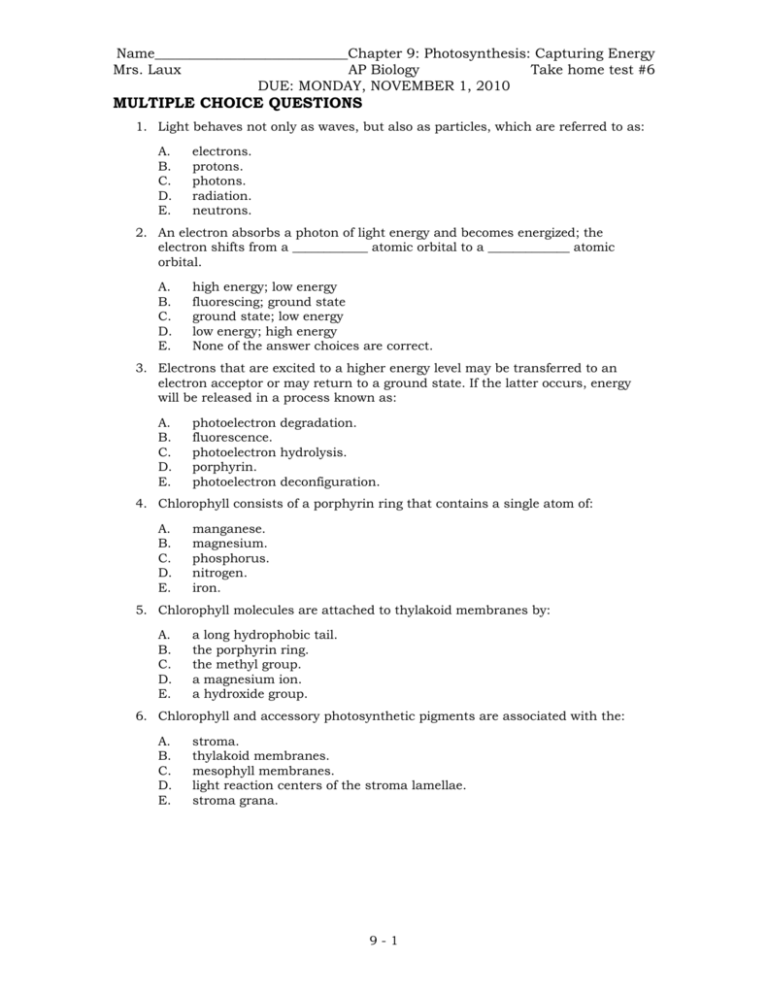
Name____________________________Chapter 9: Photosynthesis: Capturing Energy Mrs. Laux AP Biology Take home test #6 DUE: MONDAY, NOVEMBER 1, 2010 MULTIPLE CHOICE QUESTIONS 1. Light behaves not only as waves, but also as particles, which are referred to as: A. B. C. D. E. electrons. protons. photons. radiation. neutrons. 2. An electron absorbs a photon of light energy and becomes energized; the electron shifts from a ____________ atomic orbital to a _____________ atomic orbital. A. B. C. D. E. high energy; low energy fluorescing; ground state ground state; low energy low energy; high energy None of the answer choices are correct. 3. Electrons that are excited to a higher energy level may be transferred to an electron acceptor or may return to a ground state. If the latter occurs, energy will be released in a process known as: A. B. C. D. E. photoelectron degradation. fluorescence. photoelectron hydrolysis. porphyrin. photoelectron deconfiguration. 4. Chlorophyll consists of a porphyrin ring that contains a single atom of: A. B. C. D. E. manganese. magnesium. phosphorus. nitrogen. iron. 5. Chlorophyll molecules are attached to thylakoid membranes by: A. B. C. D. E. a long hydrophobic tail. the porphyrin ring. the methyl group. a magnesium ion. a hydroxide group. 6. Chlorophyll and accessory photosynthetic pigments are associated with the: A. B. C. D. E. stroma. thylakoid membranes. mesophyll membranes. light reaction centers of the stroma lamellae. stroma grana. 9-1 Name____________________________Chapter 9: Photosynthesis: Capturing Energy Mrs. Laux AP Biology Take home test #6 DUE: MONDAY, NOVEMBER 1, 2010 7. The most important photosynthetic pigment(s) is(are): A. B. C. D. E. carotenoids. xanthophylls. chlorophyll a. chlorophyll b. All of these are equally important for photosynthesis. 8. The ____________________ of a chlorophyll molecule is (are) responsible for absorbing light. A. B. C. D. E. carbon atoms porphyrin ring methyl group magnesium ion long hydrophobic tail 9. In a chloroplast, there is an outer and an inner membrane. The inner membrane encloses a fluid filled region called the: A. B. C. D. E. grana. thylakoid. stroma. pigment. electron acceptor. 10. The thylakoid membrane encloses a space called the: A. B. C. D. E. lumen. stroma. granum. mesophyll. porphyrin. 11. Thylakoid membranes are involved in _____ synthesis. A. B. C. D. E. glucose NADP ATP RuBP PEP 12. Chlorophyll: A. B. C. D. E. reflects red and blue light, and absorbs green light. transmits red and blue light, and absorbs green light. transmits red and blue light, and reflects green light. absorbs red and blue light, and reflects green light. absorbs red, blue, and green light. 13. Accessory photosynthetic pigment that expands the spectrum of light that provides energy for photosynthesis: A. B. C. D. E. carotenoids. chlorophyll a. chlorophyll b. Both caroternois and chlorophyll a. Both carotenoids and chlorophyll b. 9-2 Name____________________________Chapter 9: Photosynthesis: Capturing Energy Mrs. Laux AP Biology Take home test #6 DUE: MONDAY, NOVEMBER 1, 2010 14. The action spectrum of photosynthesis best matches the absorption spectrum of: A. B. C. D. E. NADPH. carotenoids. chlorophyll. xanthophylls. anthocyanin. 15. Chlorophyll absorbs primarily _____ and _____ regions of the visible spectrum. A. B. C. D. E. blue; red green; yellow red; green red; yellow blue; yellow 16. Engelmann concluded that chlorophyll in the chloroplasts is responsible for photosynthesis based on the following results: A. B. C. D. E. Spirogyra cells each contain a long, spiral-shaped, emerald-green chloroplast embedded in the cytoplasm. The action spectrum of photosynthesis matched the maximum production of oxygen by Spirogyra, observed by the greatest accumulation of bacteria in the blue and red regions of the spectrum. Bacteria exposed to the action spectrum for photosynthesis showed no preference to any particular color of light. Accessory pigments transfer some of the energy of excitation produced by green light to chlorophyll molecules. None of these answer choices is correct. 17. The overall reactions of photosynthesis are best summarized as: A. B. C. D. E. 12 CO2 + 6 H2O → C6H12O6 + 12 O2 + 6 H2O. C6H12O6 + 6 O2 + 6 H2O → 6 CO2 + 12 H2O. 6 CO2 + 12 H2O → C6H12O6 + 6 O2 + 6 H2O. 6 CO2 + 12 H2O → C6H12O6 + 12 O2. 6 H2CO3 + 6 H2O → C6H12O6 + C6H12O6 + 6 H2O + 6 O2. 18. During the reactions of photosynthesis, ____________ is reduced and ____________ is oxidized. A. B. C. D. E. O2; C6H12O6 CO2; C6H12O6 H2O; C6H12O6 O 2; H 2O CO2; H2O 19. In the overall reactions of photosynthesis, it appears that hydrogen atoms are transferred from water to carbon dioxide to form a carbohydrate. This type of reaction is classified as: A. B. C. D. E. a redox reaction. an anaerobic reaction. a catabolic reaction. an oxidation reaction. a hydrolytic reaction. 9-3 Name____________________________Chapter 9: Photosynthesis: Capturing Energy Mrs. Laux AP Biology Take home test #6 DUE: MONDAY, NOVEMBER 1, 2010 20. The reactions of photosynthesis are divided into two categories: A. B. C. D. E. light-independent reactions and carbon fixation reactions. carbon fixation reactions and oxygen fixation reactions. light-dependent reactions and carbon fixation reactions. light-dependent reactions and citric acid cycle. chemiosmosis and photochemical reactions. 21. In photosynthesis, ATP and NADPH are produced during: A. B. C. D. E. the carbon fixation reactions. the light-dependent phase. the light-independent phase. glycolysis. photolysis. 22. The reactants of the light-dependent reactions are: A. B. C. D. E. H2O, ADP, and NADP+. CO2, ADP, and NADP+. H2O, ATP, and NADPH. CO2, ADP, and NADPH. H2O, CO2, and NADP+. 23. The reactants of the Calvin cycle are: A. B. C. D. E. H2O, ATP, and NADPH. CO2, ADP, and NADP+. CO2, ATP, and NADPH. H2O, ATP, and NADPH. CO2, H2O, and ATP. 24. Which of the following is not associated with the thylakoid membranes? A. B. C. D. E. photosystems I and II the Calvin cycle electron transport chain ATP synthase antenna complex 25. 12 H2O + 12 NADP+ + 18 ADP + Pi → 6 O2 + 12 NADPH + 18 ATP summarizes the ____________ reactions of photosynthesis. A. B. C. D. E. carbon fixation light-dependent light-independent CAM electron transport 26. The electron transport chain of photosynthesis is located in the: A. B. C. D. E. cristae. mitochondria. outer chloroplast membrane. chloroplast stroma. thylakoid membrane. 9-4 Name____________________________Chapter 9: Photosynthesis: Capturing Energy Mrs. Laux AP Biology Take home test #6 DUE: MONDAY, NOVEMBER 1, 2010 27. Reaction center complexes of the light-dependent reactions contain ____________ and ____________, which receive energy from ____________. A. B. C. D. E. accessory pigments; chlorophyll; antenna complexes carotenoids; proteins; chlorophyll chlorophyll; antenna complexes; carotenoid proteins; antenna complexes; carotenoid chlorophyll; proteins; antenna complexes 28. How many electrons are needed to reduce one molecule of NADP+ to NADPH? A. B. C. D. E. 1 2 3 4 5 29. During the light-dependent reactions of photosynthesis, a constant supply of electrons is provided by: A. B. C. D. E. water. oxygen. the sun. chlorophyll. carotenoids. 30. Oxygen produced by photosynthesis comes directly from: A. B. C. D. E. light. CO2. glucose. H2O. ATP. 31. ATP is formed when __________________ the thylakoid lumen. A. B. C. D. E. hydrogen ions enter hydrogen ions leave electrons enter electrons leave water is split in 32. The synthesis of ATP as a result of the light-dependent reactions of photosynthesis is an ____________ reaction that is coupled to the diffusion of ____________ down their concentration gradient. A. B. C. D. E. endergonic; protons energy-releasing; hydrogen ions exergonic; electrons energy-acquiring; electrons oxidation; water 33. The synthesis of ATP during photosynthesis or respiration occurs as a result of: A. B. C. D. E. phosphorylation of AMP. phosphorylation of ATP. phosphorylation of ADP. phosphorylation of G3P. oxidation of NADPH. 9-5 Name____________________________Chapter 9: Photosynthesis: Capturing Energy Mrs. Laux AP Biology Take home test #6 DUE: MONDAY, NOVEMBER 1, 2010 34. The first step in the Calvin cycle is the attachment of carbon dioxide to: A. B. C. D. E. E. Rubisco. glyceraldehyde 3-phosphate (G3P). phosphoglycerate RuBP (ribulose bisphosphate). None of the above. None of these; all are shared by both processes. 35. Which of the following is common to both photosynthesis and aerobic respiration? A. B. C. D. E. NADP+ and NADPH glycolysis chemiosmosis CO2 and O2 as end products thylakoids 36. Ribulose phosphate is synthesized from: A. B. C. D. E. NADP+. pyruvate. G3P. RuBP. CO2. 37. Which of the following is not one of the intermediates or products of the carbon fixation reactions? A. B. C. D. E. NADPH phosphogylcerate (PGA) glyceraldehyde 3-phosphate glucose ribulose bisphosphate 38. In C4 plants, reactions that fix CO2 into four-carbon compounds occur in: A. B. C. D. E. guard cells. epidermal cells. bundle sheath cells. mesophyll cells. xylem cells. 39. At night, CAM plants incorporate CO2 into ____________, which is stored in the ____________ of their cells. A. B. C. D. E. fructose; vacuoles acetyl CoA; mitochondria glucose; starch granules pyruvate; starch granules malate; vacuoles 40. Animals, fungi, and many bacteria that use organic molecules as a source of both energy and carbon are: A. B. C. D. E. photoautotrophs. catabolic autotrophs. chemoheterotrophs. photoheterotrophs. chemoautotrophs. 9-6


